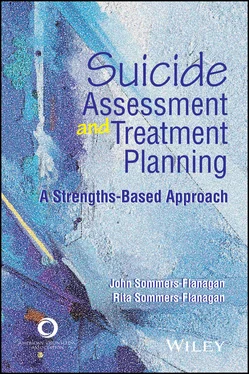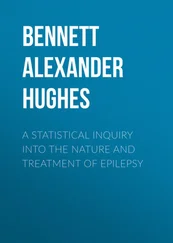John Sommers-Flanagan - Suicide Assessment and Treatment Planning
Здесь есть возможность читать онлайн «John Sommers-Flanagan - Suicide Assessment and Treatment Planning» — ознакомительный отрывок электронной книги совершенно бесплатно, а после прочтения отрывка купить полную версию. В некоторых случаях можно слушать аудио, скачать через торрент в формате fb2 и присутствует краткое содержание. Жанр: unrecognised, на английском языке. Описание произведения, (предисловие) а так же отзывы посетителей доступны на портале библиотеки ЛибКат.
- Название:Suicide Assessment and Treatment Planning
- Автор:
- Жанр:
- Год:неизвестен
- ISBN:нет данных
- Рейтинг книги:4 / 5. Голосов: 1
-
Избранное:Добавить в избранное
- Отзывы:
-
Ваша оценка:
- 80
- 1
- 2
- 3
- 4
- 5
Suicide Assessment and Treatment Planning: краткое содержание, описание и аннотация
Предлагаем к чтению аннотацию, описание, краткое содержание или предисловие (зависит от того, что написал сам автор книги «Suicide Assessment and Treatment Planning»). Если вы не нашли необходимую информацию о книге — напишите в комментариях, мы постараемся отыскать её.
Suicide Assessment and Treatment Planning — читать онлайн ознакомительный отрывок
Ниже представлен текст книги, разбитый по страницам. Система сохранения места последней прочитанной страницы, позволяет с удобством читать онлайн бесплатно книгу «Suicide Assessment and Treatment Planning», без необходимости каждый раз заново искать на чём Вы остановились. Поставьте закладку, и сможете в любой момент перейти на страницу, на которой закончили чтение.
Интервал:
Закладка:
198 194
199 195
200 196
201 197
202 198
203 199
204 200
205 201
206 203
207 204
208 205
209 206
210 207
211 208
212 209
213 210
214 211
215 213
216 214
217 215
218 216
219 217
220 218
221 219
222 220
223 221
224 222
225 223
226 224
227 225
228 226
229 227
230 228
231 229
232 230
233 231
234 232
235 233
236 235
237 236
238 237
239 238
240 239
241 240
242 241
243 242
244 243
245 244
246 245
247 246
248 247
249 248
250 249
251 250
252 251
253 252
254 253
255 254
256 255
257 256
258 257
259 258
260 259
261 260
262 261
263 262
264 263
265 264
266 265
267 266
268 267
269 268
270 269
271 270
272 271
273 272
274 273
275 274
276 275
277 276
278 277
279 278
280 279
281 280
282 281
283 282
284 283
285 284
286 285
287 286
288 287
289 288
290 289
291 290
292 291
Suicide Assessment and Treatment Planning
A Strengths-Based Approach
John Sommers-Flanagan
Rita Sommers-Flanagan

6101 Stevenson Avenue, Suite 600
Alexandria, VA 22304
www.counseling.org
Copyright © 2021 by the American Counseling Association. All rights reserved. Printed in the United States of America. Except as permitted under the United States Copyright Act of 1976, no part of this publication may be reproduced or distributed in any form or by any means, or stored in a database or retrieval system, without the written permission of the publisher.
American Counseling Association6101 Stevenson Avenue, Suite 600 • Alexandria, VA 22304
Associate Publisher • Carolyn C. Baker
Digital and Print Development Editor • Nancy Driver
Senior Production Manager • Bonny E. Gaston
Copy Editor • Beth Ciha
Cover and text design by Bonny E. Gaston
Library of Congress Cataloging-in-Publication DataNames: Sommers-Flanagan, John, 1957– author. | Sommers-Flanagan, Rita, 1953– author. Title: Suicide assessment and treatment planning : a strengths-based approach / John Sommers-Flanagan and Rita Sommers-Flanagan. Description: Alexandria, VA : American Counseling Association, [2021] | Includes bibliographical references and index. Identifiers: LCCN 2020041407 | ISBN 9781556204050 (paperback) Subjects: LCSH: Suicidal behavior—Diagnosis | Suicidal behavior—Treatment Classification: LCC RC569 .S64 2021 | DDC 616.85/8445--dc23 LC record available at https://lccn.loc.gov/2020041407
DEDICATION
We dedicate this book to all the school, mental health,health care professionals, and students who are so busysaving lives that they will probably skip this dedication.We see you, and we honor you and your work.
Preface
Writing a book about suicide may not have been our best idea ever. Rita made the point more than once that reading and writing about suicide at the depth necessary to write a helpful book can affect one’s mood in a downward direction. She was right, of course. Her rightness inspired us to pay attention to the other side of the coin, so we decided to integrate positive psychology and the happiness literature into this book. As is often the case when grappling with matters of humanity, focusing on suicide led us to a deeper understanding of suicide’s complementary dialectic—a meaningful and fully lived life—and that has been a very good thing.
Before diving into these pages, please consider the following.
Do the Self-Care Thing
In the first chapter, we strongly emphasize how important it is to practice self-care when working with clients who are suicidal. Immersing ourselves in the suicide literature required a balancing focus on positive psychology and wellness. While you are reading this book and exploring suicide, you cannot help but be impacted emotionally, and we cannot overstate the importance of you taking care of yourself throughout this process and into the future. You are the instrument through which you provide care for others, and so we highly encourage you to repeatedly do the self-care thing.
What Is a Strengths-Based Approach?
Many people have asked, “What on earth do you mean by a strengths-based approach to suicide assessment and treatment planning?” In response, we usually meander in and out of various bullet points, relational dynamics, and assessment procedures and try to emphasize that the approach is more than just strengths based—it is also wellness oriented and holistic. By “strengths based,” we mean that we recognize and nurture the existing and potential strengths of our clients. By “wellness oriented,” we mean that we believe in incorporating wellness activities into counseling and life. By “holistic,” we mean that we focus on emotional, cognitive, interpersonal, physical, cultural-spiritual, behavioral, and contextual dimensions of living.
You will find the following strengths-based, wellness-oriented, and holistic principles woven into every chapter of this book: Empirically supported is used when there is substantial and specific research support; evidence based is used when there is general research support, but that support may not be especially robust or specific. We avoid using best practice because this phrase implies direct comparisons and rank orderings of all potential practices (which have not been done) and is often used to communicate normative practice standards rather than procedures with underlying empirical support.
1 Historically, suicidal ideation has been socially constructed as sinful, illegal, or a terribly frightening and bad illness. In contrast, we believe that suicidal ideation is a normal variation on human experience that typically stems from difficult environmental circumstances and excruciating emotional pain. Rather than fear client disclosures of suicidality, we welcome these disclosures because they offer an opportunity to connect deeply with distressed clients and provide therapeutic support.
2 Although we believe that risk factors, warning signs, protective factors, and suicide assessment instruments are important, we value relationship connections with clients over predictive formulae and technical procedures.
3 We believe that trust, empathy, collaboration, and rapport will improve the reliability, validity, and utility of data gathered during assessments. Consequently, we embrace the principles of therapeutic assessment.
4 We believe that counseling practitioners need to ask directly about and explore suicidal ideation using a normalizing frame or other sophisticated and empathic interviewing strategies.
5 We believe that traditional approaches to suicide assessment and treatment are excessively oriented toward psychopathology. To compensate for this pathology orientation, we explicitly value and ask about clients’ positive experiences, personal strengths, and coping strategies.
6 We believe that the narrow pursuit of psychopathology causes clinicians to neglect a more complete assessment and case formulation of the whole person. To compensate, we use a holistic, seven-dimension model to create a broader understanding of what is hurting and what is helping in each individual client’s life.
Читать дальшеИнтервал:
Закладка:
Похожие книги на «Suicide Assessment and Treatment Planning»
Представляем Вашему вниманию похожие книги на «Suicide Assessment and Treatment Planning» списком для выбора. Мы отобрали схожую по названию и смыслу литературу в надежде предоставить читателям больше вариантов отыскать новые, интересные, ещё непрочитанные произведения.
Обсуждение, отзывы о книге «Suicide Assessment and Treatment Planning» и просто собственные мнения читателей. Оставьте ваши комментарии, напишите, что Вы думаете о произведении, его смысле или главных героях. Укажите что конкретно понравилось, а что нет, и почему Вы так считаете.











